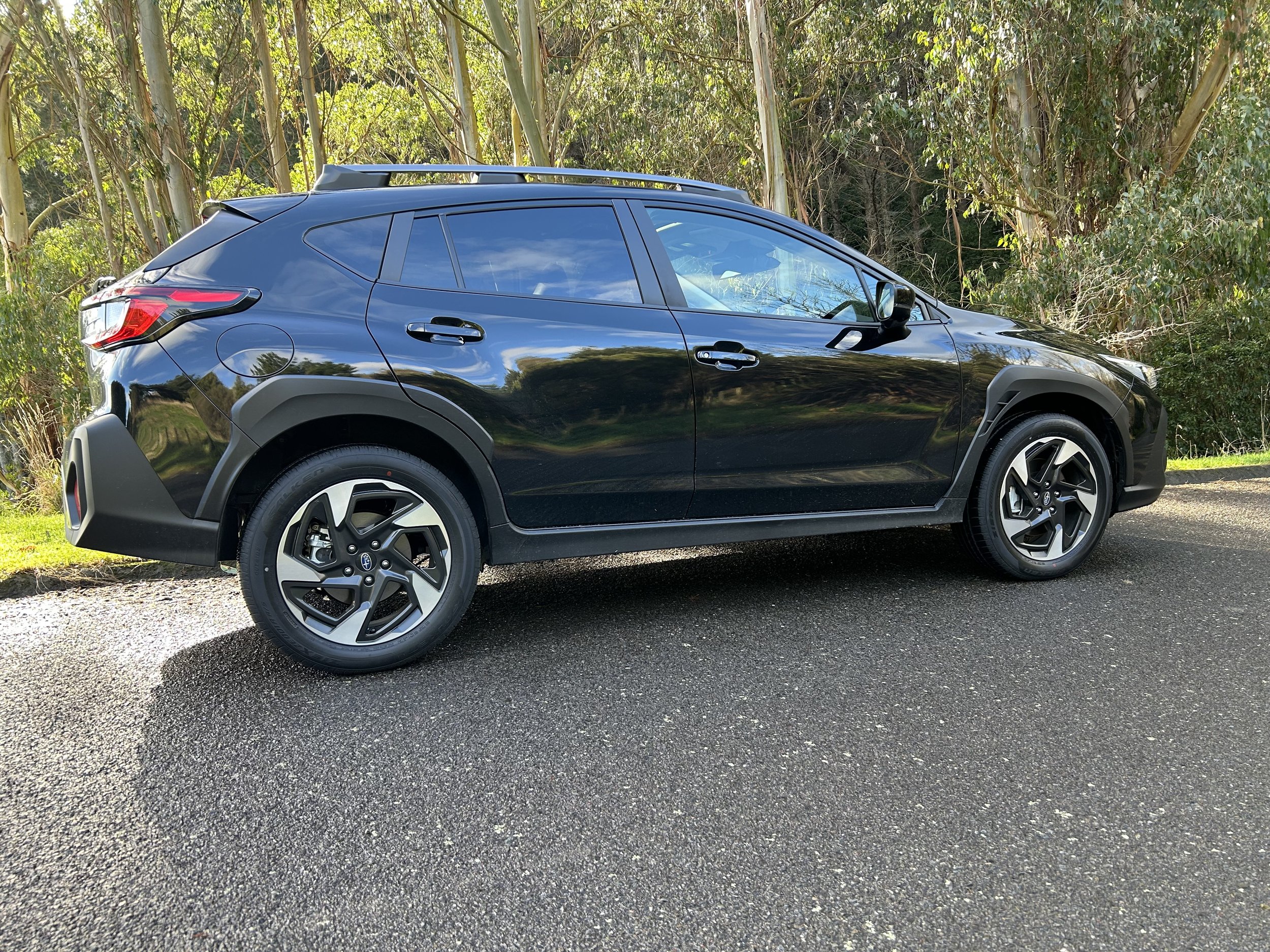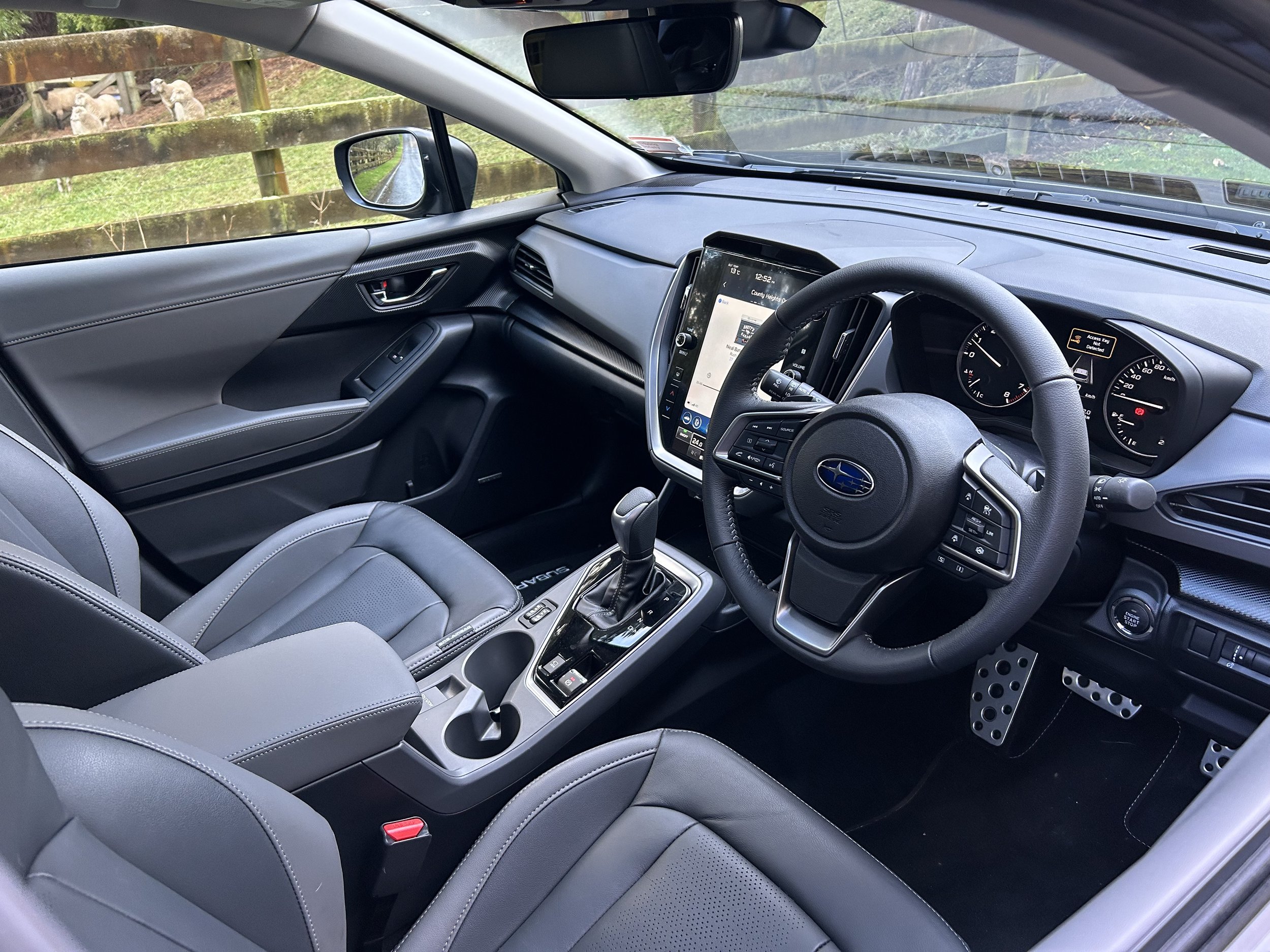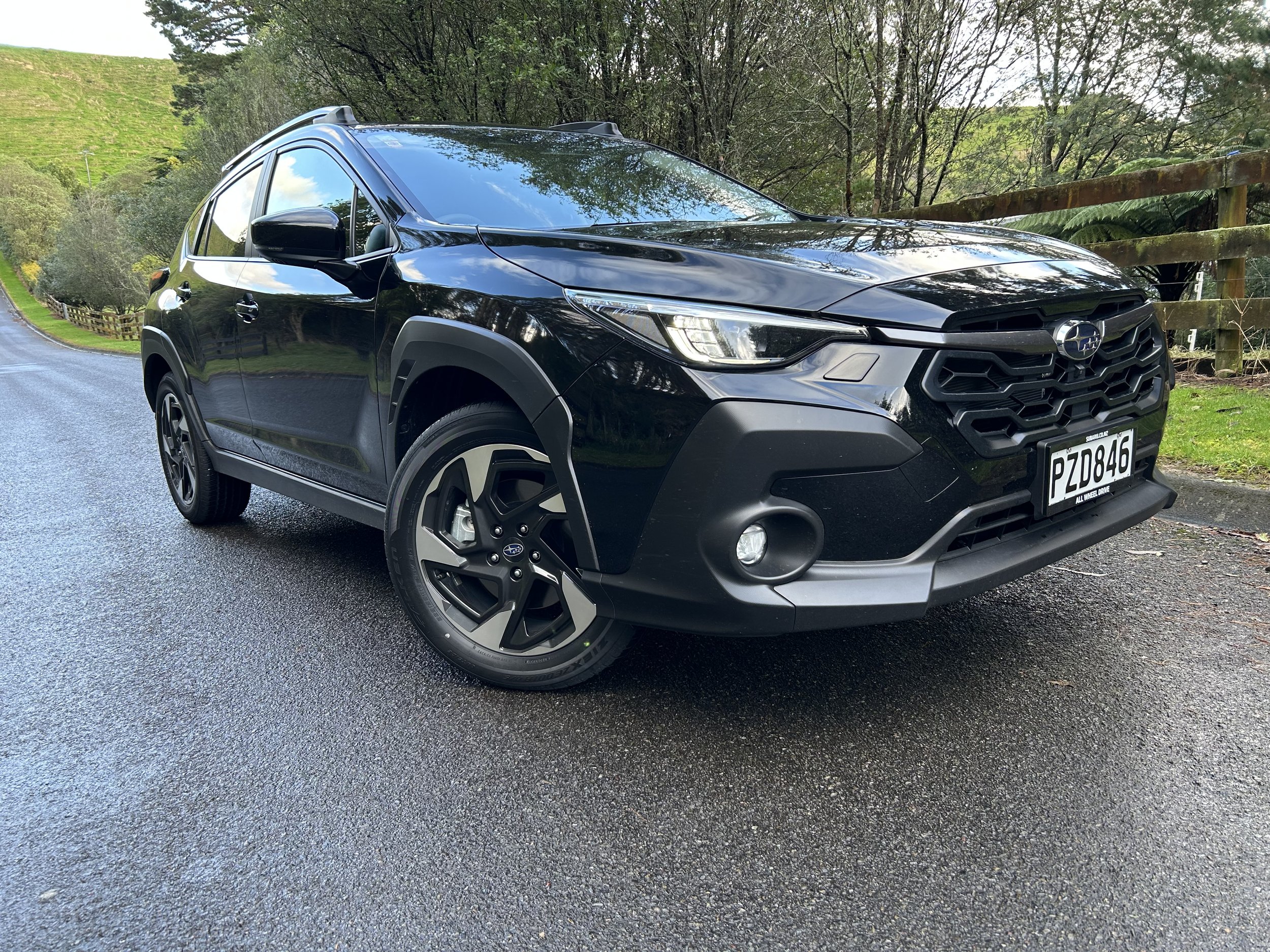Subaru Crosstrek Premium roadtest review: Boxer feeling the bash
/The smallest of this brand’s sports utilities earns new tech and still hits its marks off-seal, but is mired for performance.
Price: $48,990.
Powertrain: 2.0-litre four-cylinder horizontally-opposed petrol, 115kW power and 196Nm torque, permanent all wheel drive, 7.2 litres per 100km cited economy, 165g/km CO2.
Vital statistics: 4495mm long, 1800mm wide, 1600mm high, 2670mm wheelbase, 291 litres luggage capacity, 225/55 R18 tyres.
We like: Improved specification, impressive beyond-seal ability and excellent traction everywhere, loaded with safety kit.
Not so much: Short on verve; small boot; least characterful Subaru SUV; getting pricey.
GETTING stuck in a rut isn’t easily achieved by Subaru’s off-road oriented models - they’re famous for being ruggedly able and that’s why New Zealanders have found them so easy to own.
Bend ‘em, bash ‘em, batter ‘em … they’ll take all that. It’s the breaking they’re impervious to. The brand’s lineage of five-door elevated models have proven to be impressively resilient and that’s one reason why they’ve for years been so popular with adventure-seeking outdoorsy types; far more so than heavier-metal choices with much longer global lineages. It’s been a great run.
Decent snow, sand and mud capability boxes ticked, Subaru now faces up to a tougher test. Is there any irony that vehicles designed to deliver outdoors enthusiasts to the places they cherish are by and large on the wrong side of Clean Car; whose impetus is to bring the Earth back to better health? If so, no-one’s laughing, least of all this brand.
Subaru is feeling Clean Car pain. Having cars that tread relatively lightly when venturing into the wild doesn’t lend entry to the eco warrior brigade; exhaust emissions are in the black. It hasn’t a car on sale just now that isn’t somewhat penalised by the emissions’ reduction legislation. Until that changes, there’s no Green badge of virtue for the Fuji troupe.
The wholly electric Solterra all-wheel-drive that is supposed to be here before year-end is the ace card they need to hold. It cannot come soon enough. Carbon credits the battery-reliant rock hopper earns are sorely needed to assuage the penalty payment pain suffered by others that pledge to petrol-fed horizontally-opposed four-cylinders whose contribution to worse than average fuel consumption and CO2 figures was already a significant consideration before the Government added its own penalty.
The Crosstrek on test here is so blighted; it comes with two kinds of 2.0-litre petrol powertrain, and that one version has hybrid assist is of no help. The pure petrol Premium on test is whacked by a $2830 Clean Car penalty on purchase. Being battery-enlivened doesn’t keep the hybrid from humping a $1380 load. On top of this, Subaru has Clean Car Standard fees to cope with. It’s not a happy camper.
Still, Subaru has a strong brand image and the buyer type for this car is emphatically attuned to fresh air lifestyle. Eighty-seven percent of Subaru NZ’s Crosstrek customers consider “keeping fit” being a priority; 69 percent also own dogs.
Hence why the advertising campaigns portray this car off-road, often in a rugged but need-to-see landscape, setting off or reaching somewhere accessible only by using only a vehicle with a clever all-wheel-drive system - and Subaru’s proprietary X-mode remains one of the best - decent ground clearance and a never-say-die adventuresome attitude. Hence why Subaru is confident past owners will remain loyal. It can count on quite a few. Even though this type has been a runt of the litter volume-wise, there are still plenty around: Subaru NZ sold 7000 new examples and guesstimates that the herd is around 20,000 strong when used imports are included.
The Crosstrek name is new here, but the car it attaches to clearly isn’t. The car here is a new and third generation of what we’ve almost always called the XV.
That the Crosstrek has a fresh identity doesn’t mean it makes a fresh start.
Yes, it delivers with altered exterior styling, that matches Subaru's current design language. Adoption of chunkier exterior plastic bits, including angular wheelarch flares that are similar to those on the latest Outback, lifts the look. The front end is more aggressive with narrower LED headlamps. Not sure about the bulked up rear, though; it looks like a plastic nappy from some angles.
It also has interior updates - the most obvious being it securing the 11.6-inch vertical tablet centre console screen from Outback.
Yet there are enough commonalities to make firm connection with the outgoing product and, if you see old and new in the street, there’s still need for a badge check to confirm which is which.
Same platform, same powertrains feeding through a constantly variable transmission and - though the bias has changed from a 50:50 split to 60:40 - the same symmetrical all-wheel-drive.
Same driving feel? Not exactly, but it’s familiar enough. Even though the stance and elevated seating lends a more commanding view of the road than you get from a conventional sedan or hatchback, the Crosstrek is still more like a family runabout. It avoids that small truck feel.
As much as that’s a plus, it also hasn’t the driving ambience of the next size up Forester or the ultimate level, station wagon-based Outback. It feels usefully lighter, but less solid. The suspension has a lot of flexiblity, but ride quality-wise the larger fare are still more serene over bumps.
Even so, the car’s pert dimension lends itself to being useful in tight spots and improvements to body rigidity (now claimed to be on par with WRX), suspension tune and the traction became evident during the seven day driving stint.
This time, in addition to driving on seal, the car was put onto gravel and also across several poorly-formed tracks. It took on everything without fuss; there was no shirking the challenges.
On major roads, it is a car that scampers relatively assertively through corners and appears to have sharper turn-in, so though steering feel at dead-centre is a bit vague, it demonstrates less of the body roll than more top-heavy rivals, with tenacious traction and grip.
Subarus relish gravel and tracks onto which you might have to take on to get to a favourite fishing spot; they’re a good choice for a farm visit or, of course, reaching a skiing area. A lot of Subarus live in snow country for good reason.
Subaru’s all-wheel-drive systems are rock solid and the X-Drive technology adds to the trustworthiness. Even when the road-tuned rubber starts to wilt, the all-paw continues to work above and beyond. Crosstrek’s system has a two-mode tweak, active only below 20kmh, that commands a lower ‘ratio’, as it were, from the CVT. The throttle modulation could be better but it’s surprisingly game through mud and when facing steep, slippery slopes; you’ll be amazed. If this all sounds like the type of terrain you anticipate taking on, then go for it.
Is there any weakness? Insofar as marketing goes, it makes sense that whereas previously there were two fully petrol-fed types and two hybrids, now the base petrol that sat at $40,990 has gone and emphasis is on those e-boxers, representing in standard and Premium guises, with the single pure petrol, also in Premium form, sitting between them.
The latter is the car on test. There are reasons why it might make better sense than the hybrid. Then again, there are also reasons why neither is really an optimal choice.
The advantage of boxer power plants is that, in laying flat across the engine bay rather than standing up vertically, this places the weight of the engine lower in the car, which helps it steer more responsively.
The engines now are far more efficient than they used to be, but not to point of being class leaders. And, obviously, they suffer a CO2 output penalty that is high enough to irk our legislators.
The bigger immediate hindrance for contemplating ownership of the FB20 in its pure petrol form is that it’s not exactly brimming with brio. Everything feels okay in normal driving but on hilly roads, or when asked to accelerate the car quickly, you’ll shake your head at the lack of verve and potency. It can get awfully thrashy, but even then simply lacks the ability to respond decisively. At those moments, as a colleague dryly pointed out, there’s “a lot of acoustic theatre happening for not a lot of go.”
The continuously variable automatic transmission can be manually operated using gear-shift paddles behind the steering wheel. You might imagine this would makes it more fun than some conventional automatics, yet often it really isn’t as it can be hesitant to drop back into the power band.
It would be interesting to revisit the Hybrid, though previous association has left impression that not too much can be expected from it. While the 2.0-litre 110kW/196Nm engine becomes a touch more muscular in its mid-range oomph with the 12.3kW/66Nm electric motor, it’s not earth-shatteringly different. In previous testing, fuel economy gains were even more slight than the modest improvement the maker suggests.
The cheapest Crosstrek has cloth trim, the Premiums take leather and a sunroof, but all variants have heated front seats and external mirrors, better LED headlamps and LED DRLs and are the first Subarus to get an updated Eyesight alert and accident system.
Formerly running two stereo cameras mounted atop the windscreen, Subaru has added a third camera to the array, which delivers a much wider viewing angle to complement the longer focal point of the two stock lenses. The Premium also has a full 360 degree surround view display. Also the model has a driver monitoring system, straight from the Outback, that’s well-meaning but a bit of a pest, overall. You need only divert your gaze for a moment and it’s scolding.
XV had a five star ANCAP rating, but that was determined in 2017 and the test became a lot tougher from the start of 2023.
There’s thought the predecessor’s score will degrade. Even though the Crosstrek has nine airbags now, including side airbags - the first for a Subaru - it lacks a front-central device that ANCAP (and its Europe-based sister organisation, NCAP) has determined as crucial to eligibility for highest star count consideration.
An ANCAP/NCAP test is scheduled for next year and in the interim it holds five stars from the Government’s self-developed Vehicle Safety Risk Rating assessment, created for new cars that bypass ANCAP scrutiny.
Slip into a Crosstrek and it’s obvious that the instruments are a lot different. It’s great to see it adopt the 11.6-inch vertically orientated centre multimedia screen from Outback; the display is sharp and the layout easy to fathom and operate; though if you’re doing that on the move, wait until the surfaces are flat and smooth else your jabs at the various icons will likely miss their mark.
Provision of an induction charging pad that’s big enough for all current smartphones is also good. A big tick for the mix of USB-A and USB-C ports. And hooray for it coming with decent wireless Apple CarPlay and a very good Harman Kardon stereo.
Beyond that, though, it’s still much the same car as before; functional and fundamentally sound, but not as practical as the Forester and still blighted by some low-rent plastics.
Designer compulsion to incorporate fake carbonfibre-looking materials should have been kyboshed. However, to be fair, everything looks to be designed to take the knocks.
Storage is plentiful, with four cup-holders, large door bins for drink bottles and a decent sized centre armrest console, too. But if you’re on a hiking trip with mates, pack lite. At 291 litres, the boot is certainly on the smaller side for this category and has a temporary spare tyre.
The XV was the cosiest of the three Subaru SUVs and it’s no roomier overall now, so three adults across the back seat can expect to rub shoulders. The roofline and door shape mean entry and egress from the back of the Crosstrek is not quite as easy as it is with some alternative SUVs, too.
The driver’s seat is better-shaped now but the general driving position hasn’t altered so, if you’re tall, you think you’re sitting a bit too close to the roof lining.
Crosstrek is pitched as the value proposition for couples and young families that might want something a bit bigger than a hatch but with the practicalities of a small SUV.
It hits the mark in some ways - the new look is eye-catching, it has some decent kit including the latest safety assists that prove their worth in Subaru’s other SUV products. It’s not that roomy, and boot size is hardly a selling point, but would work for some adventurers, who would feel confident about taking it off seal. It’s got the right stuff, insofar as the all-wheel-drive hardware goes.
What lets it down is the drivetrain. Subaru is utterly committed to CVT, so there’s steering clear of that, more’s the pity. So, really, it needs to use its spanners under the bonnet.
The 2.0-litre is more refined now, but economy hasn’t improved and too often you are left with a lot of noise and not much go. Not good enough.
If Subaru NZ is successful in securing the Wilderness edition current restricted to North America, then that would conceivably be a solution - assuming, of course, we got it with the 2.5-litre that Canadians and Americans enjoy. It’s a stronger engine.
The other solution is one Subaru is historically well-versed in: Whacking on a turbocharger. The challenge there is to keep a tight rein on emissions and economy.




















